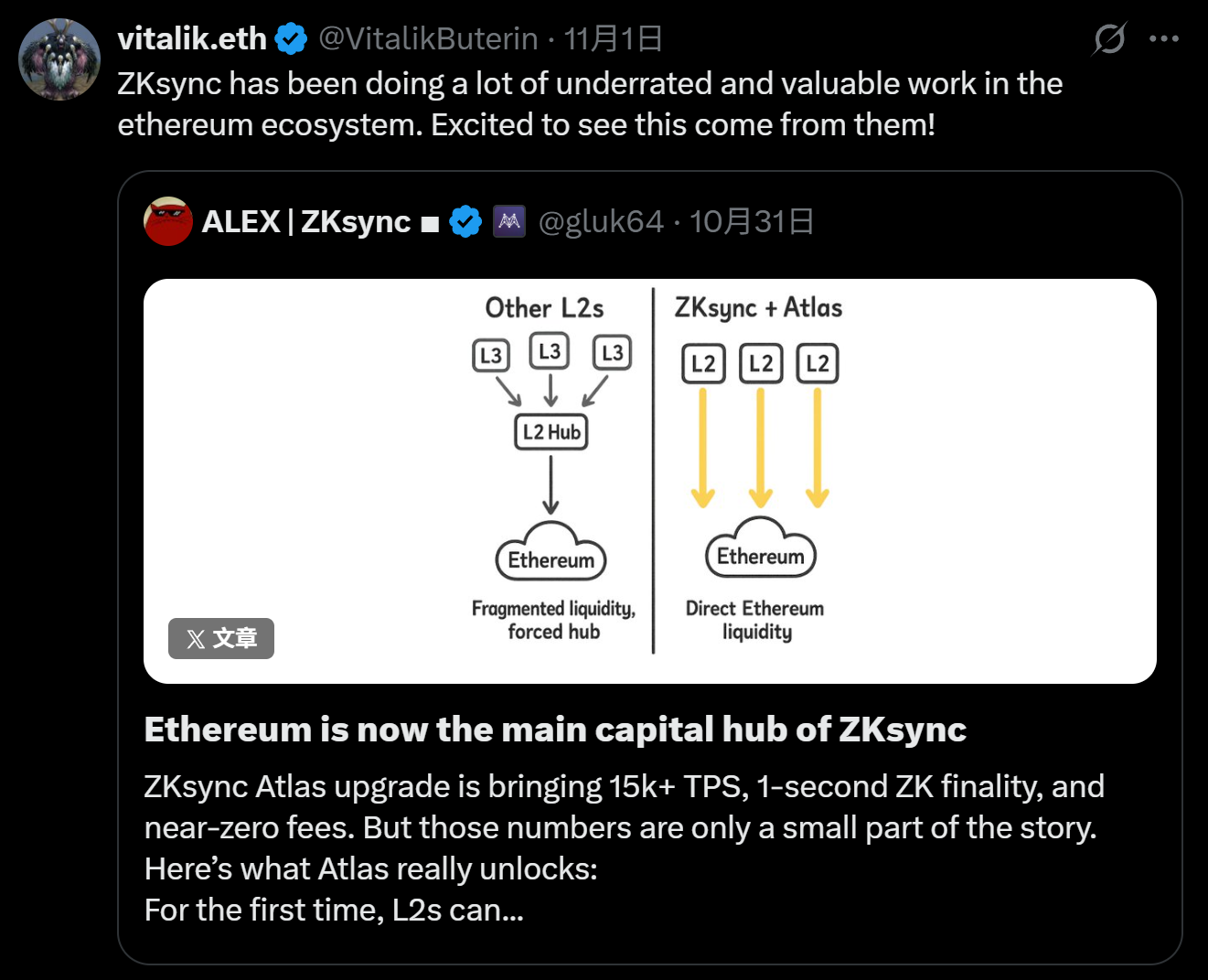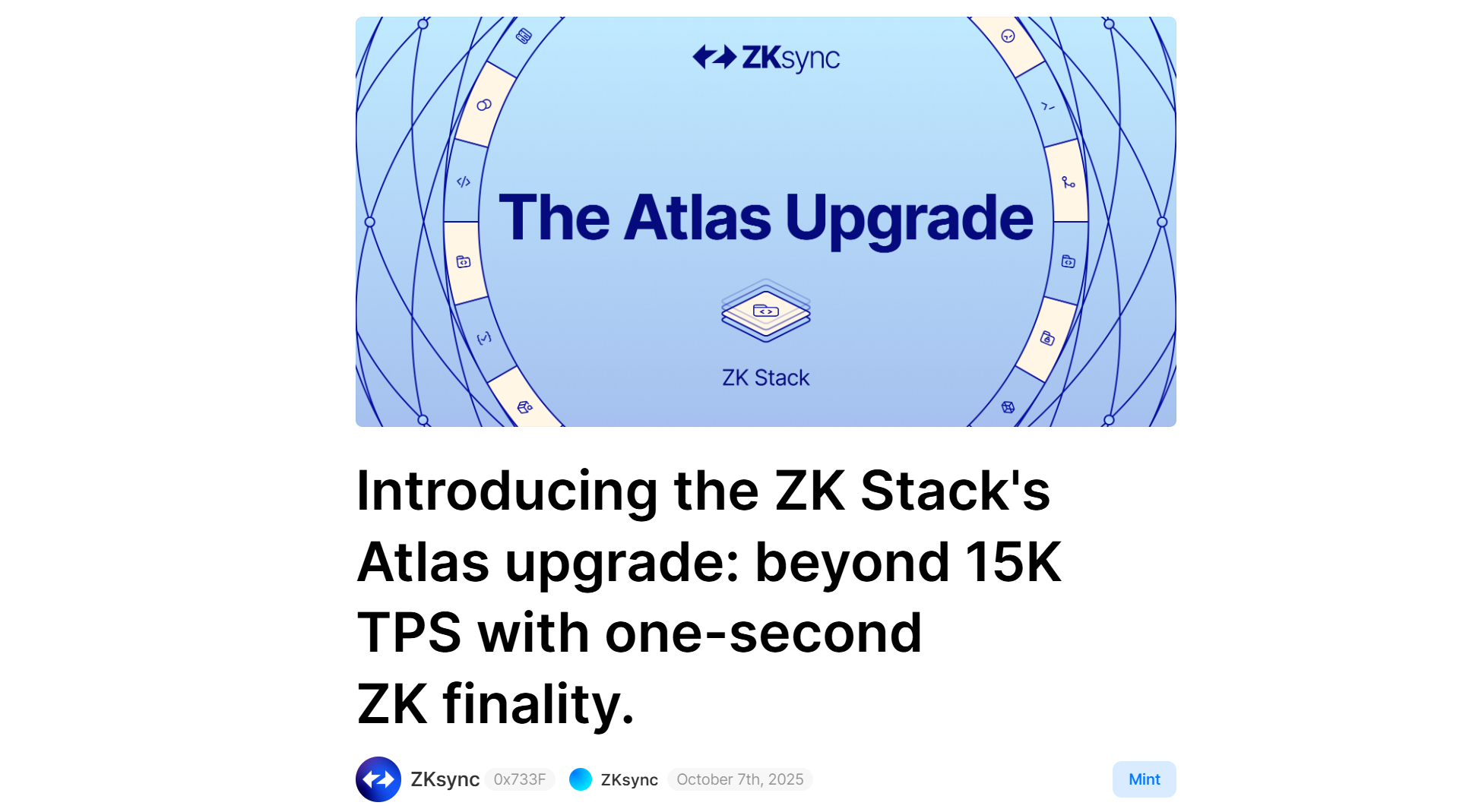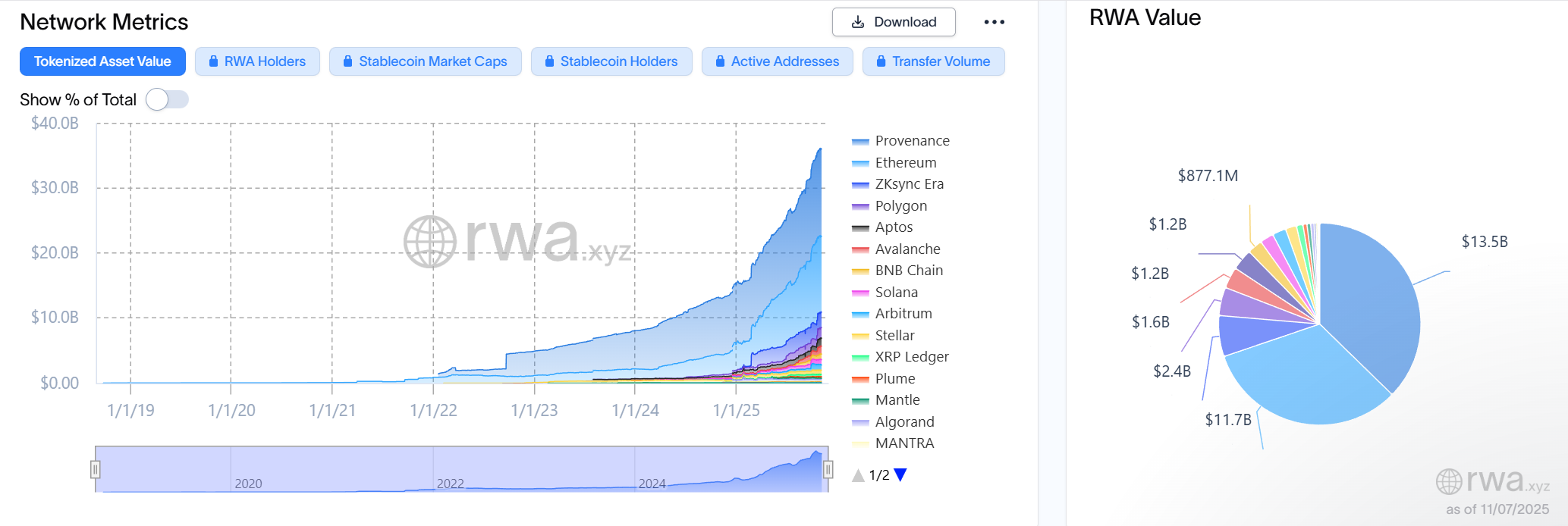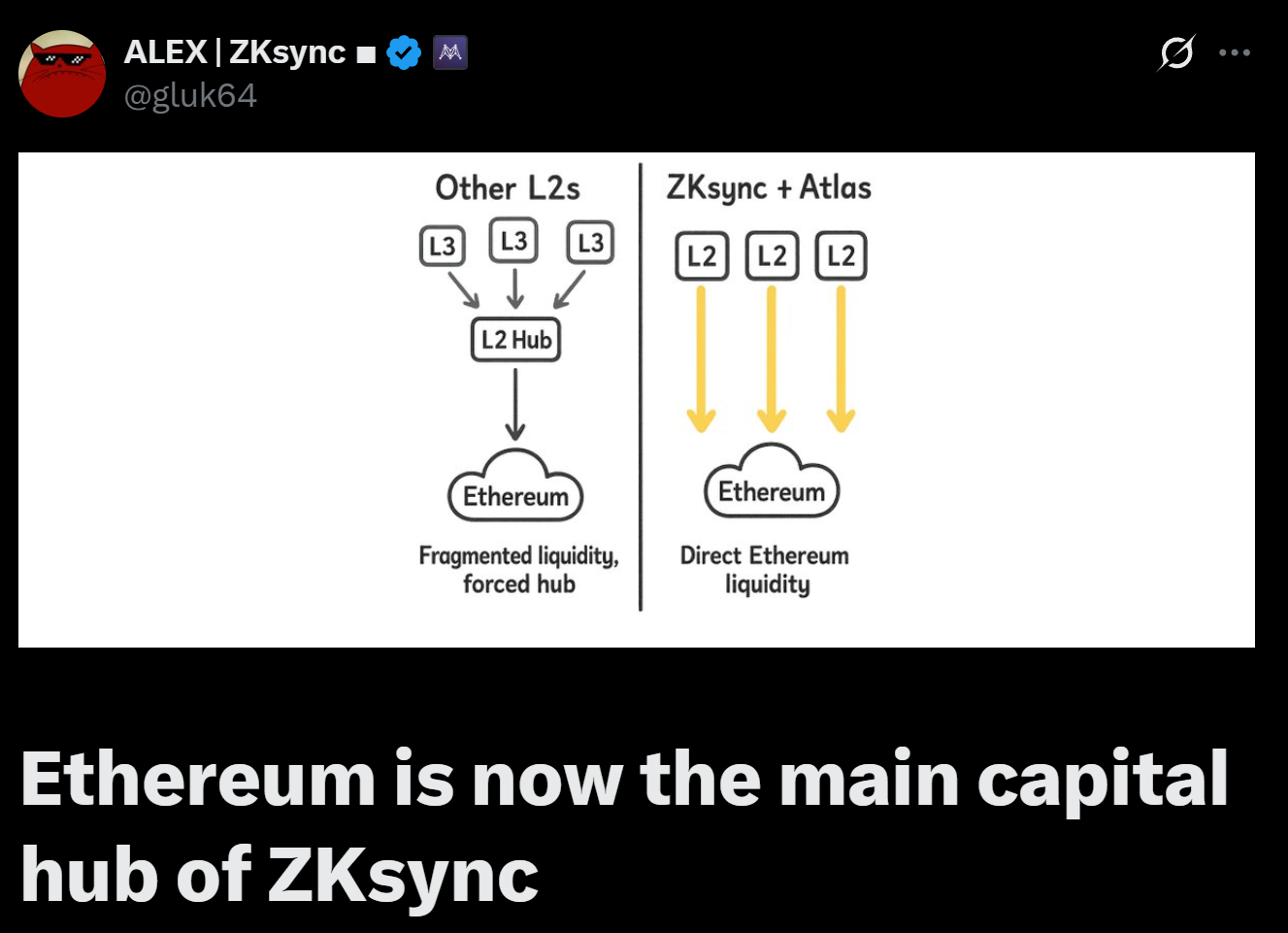ZK Roadmap "Dawn": Is the roadmap to Ethereum's endgame accelerating across the board?
- 核心观点:ZKsync成为以太坊RWA第一链。
- 关键要素:
- 链上RWA资产超24亿美元。
- 集成高性能排序器和Airbender系统。
- 推出Prividiums私有链架构。
- 市场影响:推动RWA上链和ZK技术普及。
- 时效性标注:中期影响。
Fun fact: Aside from the Ethereum mainnet, who is currently the leading RWA blockchain?
The answer is ZKsync.
Indeed, this former L2 "Big Four" project, which Vitalik recently praised for "doing a lot of undervalued but very valuable work in the Ethereum ecosystem," is becoming the most representative project example in the Ethereum ZK route.

Behind this lies a signal that Ethereum is accelerating towards its "singularity moment" in the era of zero-knowledge proofs (ZKP): Ethereum's ZK path is moving from an L2 scaling tool towards the main logic of truly reshaping trust, performance, and ecosystem structure.
An Ethereum belonging to the "proof era" is gradually taking shape.
I. ZKsync, the new standard-bearer of Ethereum ZKP
As an Ethereum scaling solution based on the ZK Rollups architecture developed by Matter Labs, ZKsync was born with a silver spoon in its mouth among many Ethereum Layer 2 projects, as it was an early ZK Rollup scaling solution funded by the Ethereum Foundation.
It can be said that since 2019, it has grown almost in tandem with Ethereum's ZK technology path:
- In March 2019, it received funding from the Ethereum Foundation's fifth wave of grants to support its work on L2 scaling with zero-knowledge proofs.
- September 2019: Secured $2 million in seed funding led by Placeholder VC;
- March 2021: Completed a $50 million Series A funding round (led by Union Square Ventures);
However, due to the long delays in the battle, ZKsync has not actually had a smooth ride in recent years.
Firstly, during the period from 2021 to 2023 when the competitive landscape of Rollups was still unclear, OP-based L2 projects such as Optimism and Arbitrum gained an advantage, while new public chains such as Solana and Aptos also rose to prominence, causing ZK-based projects such as ZKsync to be marginalized by the market due to their long iteration cycles.
ZKsync only re-entered the public eye after its mainnet launch and airdrop implementation last year, but it didn't receive widespread acclaim. Its airdrop distribution mechanism was highly controversial, the trust crisis triggered by the contract vulnerability incident had not yet subsided, and its developer, Matter Labs, was embroiled in a media storm due to alleged intellectual property disputes.
Amidst this chorus of pessimism, ZKsync's progress in both technology and ecosystem remains remarkable. It has not only continued to advance its core underlying research and development, but also officially launched the upgraded version of ZK Stack Atlas last month—a key step for ZKsync towards "enterprise-grade blockchain."

Source: ZKsync
It integrates a high-performance sorter that can process 25,000 to 30,000 transactions per second and supports the Airbender proof system with sub-second confirmation.
It is worth noting that Airbender is currently the fastest zkVM for single-GPU verification. For example, on an RTX 4090, the average verification time is only 51 seconds, and the cost is as low as $0.01, setting a new industry record.
Another significant breakthrough of ZKsync is the Prividiums private blockchain architecture, which allows enterprises to achieve fully compatible interaction with the Ethereum mainnet while ensuring privacy. It verifies the validity of transactions without exposing ledger information, achieving seamless interoperability between public and private systems.
This means that whether it's on-chain securities, cross-border payments, or foreign exchange settlement, enterprises can achieve instant clearing and privacy protection within a compliant framework —a capability that makes ZKsync an ideal underlying platform for RWA (Real-World Assets) on-chain.
This is why ZKsync stands out in the RWA field. According to data from rwa.xyz, as of the time of writing, its on-chain tokenized asset issuance has exceeded $2.4 billion, second only to the Ethereum mainnet, making it the second largest RWA issuance network in the entire network.
In other words, ZKsync is not only a testing ground for ZK technology, but also becoming the main ledger engine for putting real assets on the blockchain.

II. Has the end of zkEVM really come?
For a long time, zkEVM has been regarded as one of the "endgame solutions" for scaling Ethereum, not only because it can solve performance bottlenecks, but also because it redefines the trust mechanism of blockchain.
The core idea is to enable the Ethereum mainnet to generate and verify ZK proofs. In other words, after each block is executed, it can output a verifiable mathematical proof, allowing other nodes to confirm the correctness of the result without having to recalculate it.
Specifically, zkEVM's advantages are concentrated in three aspects:
- Faster verification: Nodes do not need to replay transactions; they only need to verify zkProof to confirm the validity of a block.
- Lighter burden: Effectively reduces the computation and storage pressure on full nodes, making it easier for light nodes and cross-chain validators to participate;
- Enhanced security: Compared to the OP route, ZK's state proofs are confirmed on-chain in real time, offering greater resistance to tampering and clearer security boundaries;
And now, all of this is rapidly becoming a reality.
Recently, the Ethereum Foundation (EF) officially released the L1 zkEVM real-time proof standard, marking the first time the ZK route has been formally incorporated into the mainnet's technical planning. This standard is considered a key starting point for the comprehensive introduction of zero-knowledge proof mechanisms— within the next year, the Ethereum mainnet will gradually transition to an execution environment that supports zkEVM verification, achieving a structural shift from "re-execution" to "verification proof".
According to the technical roadmap published by EF, the block proof latency is targeted to be controlled within 10 seconds, the size of a single ZooKeeper proof is less than 300 KB, and a 128-bit security level is adopted to avoid trusted setup. There are also plans to allow home devices to participate in proof generation, thereby lowering the threshold for decentralization.
This means that the Ethereum mainnet is no longer just a settlement layer, but has been upgraded to a "verifiable world computer" with self-verification capabilities.
Against this backdrop, ZKsync is becoming one of the earliest practitioners. Its founder, Alex, stated that with the completion of the Atlas upgrade, ZKsync has truly achieved verification integration with the Ethereum mainnet—their operating rhythm, confirmation speed, and liquidity are almost completely synchronized.

Currently, ZKsync's transaction final confirmation time is about 1 second, which is much faster than Ethereum's 12-second block interval. This means that conducting transactions on ZKsync is essentially the same as on the mainnet, requiring only waiting for mainnet confirmation. More importantly, ZK Rollup's cross-chain mechanism no longer has a 7-day challenge period like Optimistic Rollup, thus achieving an order-of-magnitude increase in transaction and fund transfer speed.
Under this structure, L2 is no longer a fragmented extension branch, but truly becomes a "parallel scaling network" of the Ethereum mainnet. Liquidity does not need to be repeatedly divided, and verification latency is significantly shortened. The "L2 fragmentation" problem that has long plagued the Ethereum ecosystem has finally found a technical solution.
III. What kind of future is Ethereum heading towards?
If you've been following Vitalik's activities on social media lately, you'll notice a clear trend—he frequently shares discussions related to Ethereum scalability, especially topics about zkEVM and the evolution of the L2 architecture.
Among these mentions, besides ZKsync, there are also representative ZK ecosystem projects such as Starknet, all pointing in the same direction: the ZK era on Ethereum is accelerating across the board.
It is worth noting that, barring any unforeseen circumstances, Ethereum's next network upgrade, Fusaka, will launch on the mainnet on December 3. This version can be considered one of the most influential network evolutions since The Merge and Dencun, with the core goal of making L2 cheaper, faster, and more open.
It brings higher data throughput to Rollup through the PeerDAS (Peer Data Availability Sampling) mechanism; at the same time, it introduces a new branch process called Blob-only parameter to reconstruct network bandwidth, storage and data writing methods, and further optimize the utilization of mainnet resources.
For Rollup developers, this means lower data writing costs and more flexible interaction space; for wallet and infrastructure providers, it means supporting more complex interactions and heavier node environments; for end users, it means lower experience costs and faster on-chain operations; and for enterprises and compliance users, EVM expansion and simplified state proofs will make on-chain interactions easier to access regulatory systems and be deployed on a large scale.
Therefore , with the joint implementation of zkEVM and Fusaka, the Rollup ecosystem is expected to enter a true stage of large-scale development. Looking back over the past few years, Ethereum's roadmap has been constantly evolving:
From The Merge's consensus upgrade to Dencun's data layering, and the upcoming Fusaka and zkEVM, the entire storyline revolves around a core issue: how to strike a balance between decentralization and scalability.
Now, the answer seems to be emerging in ZK's mathematical light.



